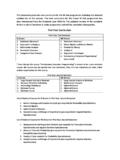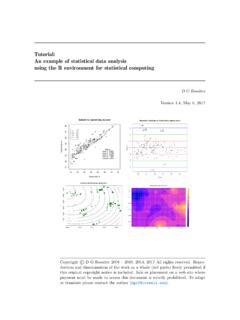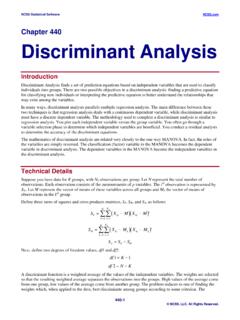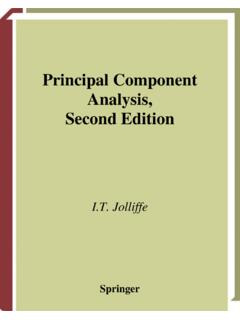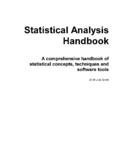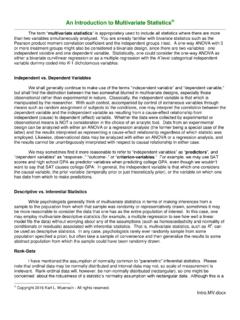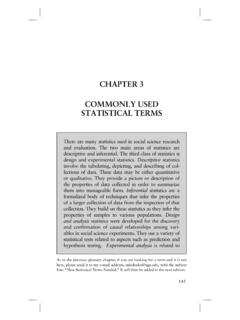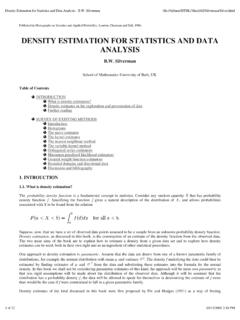Transcription of Testing Statistical Assumptions
1 Testing Statistical Assumptions 2012 Edition Copyright @c 2012 by G. David Garson and Statistical Associates Publishing Page 1 Single User License. Do not copy or Statistical Assumptions 2012 Edition Copyright @c 2012 by G. David Garson and Statistical Associates Publishing Page 2 @c 2012 by G. David Garson and Statistical Associates Publishing. All rights reserved worldwide in all media. The author and publisher of this eBook and accompanying materials make no representation or warranties with respect to the accuracy, applicability, fitness, or completeness of the contents of this eBook or accompanying materials. The author and publisher disclaim any warranties (express or implied), merchantability, or fitness for any particular purpose. The author and publisher shall in no event be held liable to any party for any direct, indirect, punitive, special, incidental or other consequential damages arising directly or indirectly from any use of this material, which is provided as is , and without warranties.
2 Further, the author and publisher do not warrant the performance, effectiveness or applicability of any sites listed or linked to in this eBook or accompanying materials. All links are for information purposes only and are not warranted for content, accuracy or any other implied or explicit purpose. This eBook and accompanying materials is copyrighted by G. David Garson and Statistical Associates Publishing. No part of this may be copied, or changed in any format, sold, or used in any way under any circumstances. Contact: G. David Garson, President Statistical Publishing Associates 274 Glenn Drive Asheboro, NC 27205 USA Email: Web: Single User License. Do not copy or Statistical Assumptions 2012 Edition Copyright @c 2012 by G. David Garson and Statistical Associates Publishing Page 3 Table of Contents Overview .. 7 Key Concepts and Terms .. 8 Parametric statistics .. 8 Nonparametric statistics .. 8 Bootstrapped estimates .. 8 Assumptions .
3 9 SOUND MEASUREMENT .. 9 Descriptive statistics .. 9 Avoiding attenuation .. 9 Avoiding tautological correlation .. 11 PROPER MODEL SPECIFICATION .. 11 Specification of a model .. 11 CELL SIZE ADEQUACY .. 11 Adequate cell size .. 11 Factor space .. 12 Cell count rule of thumb .. 12 Cell size and sample size .. 13 DATA LEVEL .. 13 Data level requirements .. 13 CENTERED DATA .. 14 Centering 14 Grand mean centering vs. group mean centering .. 15 Categorical data and centering .. 15 UNIDIMENSIONALITY .. 15 Testing unidimensionality .. 15 NORMALITY .. 17 Normal distribution .. 17 Skew .. 18 Kurtosis .. 19 Dichotomies .. 20 Single User License. Do not copy or Statistical Assumptions 2012 Edition Copyright @c 2012 by G. David Garson and Statistical Associates Publishing Page 4 Shapiro-Wilk's W test .. 20 Kolmogorov-Smirnov D test or K-S Lilliefors test .. 21 Graphical methods of assessing normality .. 22 Resampling .. 26 Normalizing Transformations.
4 26 Box-Cox Transformations of Dependent Variables .. 28 MULTIVARIATE NORMALITY .. 29 Multivariate normality .. 29 Mardia's statistic .. 29 Univariate screening for multivariate normality .. 30 Bivariate screening for multivariate normality .. 30 Residuals test.. 30 OUTLIERS .. 30 Simple outliers .. 31 Multivariate outliers .. 31 Winsorizing data .. 32 NORMALLY DISTRIBUTED ERROR .. 32 Histogram of standardized residuals .. 32 A normal probability plot .. 34 Kolmogorov-Smirnov and other normality tests .. 35 HOMOGENEITY OF VARIANCES .. 35 Levene's test of homogeneity of variances .. 36 Brown & Forsythe's test of homogeneity of variances .. 36 Example .. 36 Welch test .. 37 Bartlett's test of homogeneity of variance .. 37 F- max test .. 38 SPHERICITY .. 38 HOMOGENEITY OF VARIANCE-COVARIANCE MATRICES .. 38 Box's M test .. 38 HOMOGENEITY OF REGRESSIONS / TEST OF PARALLELISM .. 38 analysis of variance .. 38 Single User License. Do not copy or Statistical Assumptions 2012 Edition Copyright @c 2012 by G.
5 David Garson and Statistical Associates Publishing Page 5 Homogeneity of regression .. 39 Parallelism tests .. 39 HOMOSCEDASTICITY .. 39 Graphical method .. 39 Weighted least squares regression .. 40 Goldfeld-Quandt test .. 40 Glejser test .. 41 Park test .. 41 Breusch-Pagan-Godfrey test .. 41 White s test .. 41 LINEARITY .. 42 Graphical methods .. 42 Curve fitting with R-squared difference tests .. 42 ANOVA test of linearity .. 42 Eta, the correlation ratio .. 43 Adding nonlinear terms to a model .. 43 Ramsey's RESET test (regression specification error test) .. 43 MULTICOLLINEARITY .. 44 Example .. 44 Tolerance .. 45 Variance inflation factor, VIF .. 45 Condition indices.. 45 Multicollinearity in Structural Equation Models (SEM) .. 45 DATA INDEPENDENCE .. 46 Lack of independence .. 46 Intra-class correlation (ICC) .. 47 Durbin-Watson coefficient .. 47 Graphical method .. 47 RANDOMNESS .. 48 Runs Test .. 48 ADDITIVITY .. 48 Tukey's Test for nonadditivity.
6 48 Single User License. Do not copy or Statistical Assumptions 2012 Edition Copyright @c 2012 by G. David Garson and Statistical Associates Publishing Page 6 Transforms for 48 EQUALITY OF MEANS .. 48 Hotelling's T-square .. 48 Bibliography .. 50 Single User License. Do not copy or Statistical Assumptions 2012 Edition Copyright @c 2012 by G. David Garson and Statistical Associates Publishing Page 7 Overview All Statistical procedures have underlying Assumptions , some more stringent than others. In some cases, violation of these Assumptions will not change substantive research conclusions. In other cases, violation of Assumptions will undermine meaningful research. Establishing that one's data meet the Assumptions of the procedure one is using is an expected component of all quantitatively-based journal articles, theses, and dissertations. For all volumes in the Statistical Associates "blue book" series, the Assumptions of each Statistical procedure are indicated in an " Assumptions " section.
7 This volume provides a general overview of the most common data Assumptions which the researcher will encounter in Statistical research, as listed in the table of contents to the right. Single User License. Do not copy or Statistical Assumptions 2012 Edition Copyright @c 2012 by G. David Garson and Statistical Associates Publishing Page 8 Key Concepts and Terms Parametric statistics Parametric tests are significance tests which assume a certain distribution of the data (usually the normal distribution), assume an interval level of measurement, and assume homogeneity of variances when two or more samples are being compared. Most common significance tests (z tests, t-tests, and F tests) are parametric. However, it has long been established that moderate violations of parametric Assumptions have little or no effect on substantive conclusions in most instances (ex.)
8 , Cohen, 1969: 266-267.) Nonparametric statistics Nonparametric tests are ones which do not assume a particular distribution of the data. Chi-square tests are of this type. Bootstrapped estimates Bootstrapped estimates are a nonparametric approach which bases standard errors for any statistic not on Assumptions about, say, the normal curve, but on the empirical distribution arising from repeated sampling from the researcher's own dataset. In doing so, however, bootstrapping changes the meaning of the p significance value. With random sampling from a normal or known distribution, p is the probability of getting a result as strong or stronger than the observed result just by chance of taking another random sample from the population. With bootstrapping, p is the probability of getting a result as strong or stronger than the observed result just by chance of taking another sample of n-1 from the researcher's sample.
9 Single User License. Do not copy or Statistical Assumptions 2012 Edition Copyright @c 2012 by G. David Garson and Statistical Associates Publishing Page 9 Assumptions SOUND MEASUREMENT Descriptive statistics All forms of Statistical analysis assume sound measurement, relatively free of coding errors. It is good practice to run descriptive statistics on one's data so that one is confident that data are generally as expected in terms of means and standard deviations, and there are no out-of-bounds entries beyond the expected range. Avoiding attenuation When the range of the data is reduced artificially, as by classifying or dichotomizing a continuous variable, correlation is attenuated, often leading to underestimation of the effect size of that variable. Attenuation is illustrated in the figure on the following page. Single User License. Do not copy or Statistical Assumptions 2012 Edition Copyright @c 2012 by G.
10 David Garson and Statistical Associates Publishing Page 10 Single User License. Do not copy or Statistical Assumptions 2012 Edition Copyright @c 2012 by G. David Garson and Statistical Associates Publishing Page 11 Avoiding tautological correlation When the indicators for latent variable A conceptually overlap with or even include one or more of the indicators for latent variable B, definitional overlap confounds the correlation of A and B. This is particularly problemetic when indicators on the independent side of the equation conceptually overlap with indicators on the dependent side of the equation. Avoiding tautological correlation is the issue of establishing discriminant validity, discussed in the separate "blue book" volume on validity. PROPER MODEL SPECIFICATION Specification of a model Specification refers to not omitting significant causal variables or including correlated but causally extraneous ones, and also to correctly indicating the direction of arrows connecting the variables in the model.




